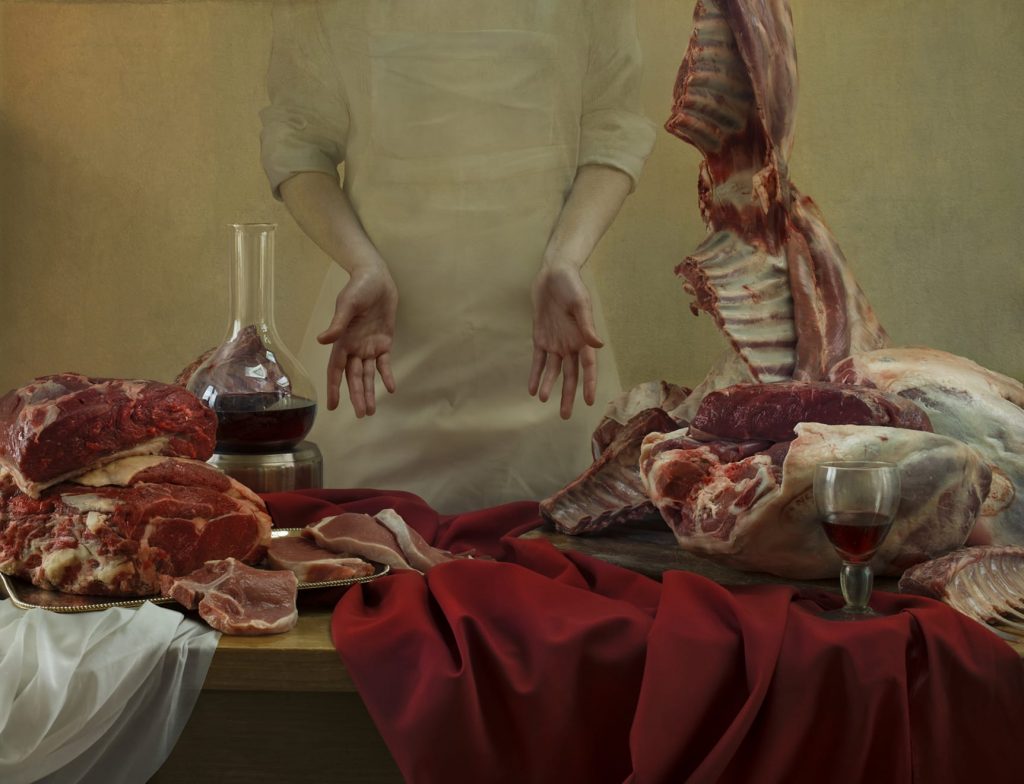In: Katerina Belkina photography

Katerina Belkina | The Dinner, 2016
February 15, 2024Katerina Belkina | The Dinner, 2016 (from the series Repast)
(Photography, Digital Painting)
“God sendeth and giveth both mouth and the meat.”
(Thomas Tusser, 1524 – 1580)
I will admit that there are certain fascinations (or perhaps less charitably or more directly classified) obsessions that ‘feed’ my interests in terms of artworks.
Meat – and how many artists employ flesh as inspiration or subject – is one of them. I offered a previous essay (centered on the fine paintings of Scott Conary) that explored this, but when I was making artworks prior to my exile or migration to Niagara (edit as you will) I often worked with fat, meat, bones and other organic matter, to make works that I described as ‘inappropriately beautiful.’
Sometimes, amidst the cacophony – or idiot choir – of ‘art criticism’ these days, with references pedantic and claiming to be ‘philosophical’ it is good to return to simply a notion of beauty. One of my best teachers, Patrick Traer – a fine artist whose work dealt with these contested, perhaps conflicting, narratives – spoke of this to me years ago, when I was still on the Prairies.
Belkina’s artwork that I share here is gripping, and perhaps inappropriately (to some weaker constitutions) beautiful. She offers some interesting ideas about her motivation and ideas that sometimes intersect with my own subjectivity, but this is an image that is striking and that, frankly, is enough.
Her religious connections are not of particular interest to me : but I must admit that my own religious upbringing (or indoctrination) have sometimes directed my interests, too – and there is a fecundity of potential interpretations that contest or converge that make her work worthy of consideration, whatever your pre existing assumptions (and I include myself in this statement).
From her site :
“Repast is an allegory of life cycles. Cyclicity perfectly characterizes humanity and our perception of time.
The Morning (childhood) means acquisition and accumulation. At the beginning of life we receive a certain foundation and potency both from our family and from the society in which we live. We learn to recognize the beauty around us and to feel it — we use all this for the rest of our lives. Even if “breakfast” is sparse in physical reality, it is often filled to the brim with intangible treasures such as love, fantasy, discoveries, strong impressions and first disappointments. In “breakfast” the abundance of dairy products is symbolic. The milk is associated with purity and virginity. The memories of breast milk are still fresh. The fullness you see is an exaggeration. The yellow of orange juice symbolizes concentrated emotions, the taste of life, sincere joy, and the energy of children. A lemon or an orange signifies the unquenchable thirst for action, knowledge, and discovery.
The Day (youth, adulthood) — creation, destruction, giving and taking. The flesh (the fruit) and the colour red are symbols of life and sacrifice. Youth is a period of expending — some build, others destroy. “Time to throw stones and gather stones” — there is a balance in this. We all make sacrifices and give everything at this point in our lives. More or less.
The Evening (age, completion) — contemplation, silence. A meditative part. Scarcity of dinner does not mean scarcity of life, or poverty. The table is set for one person. We come alone to the end of our lives, and yet we merge face to face with the divine in this world. It is a time of transition where all matter fades and loses all meaning. I believe our spirit reaches its peak here and we either accept or reject this transition completely. The set of elements depicted is simple: the fish is the symbol of Christ, the potato (the second bread) — the body losing the spirit (steam), the black tea — the drink of the gods and sages, not for simple thirst quenching, but for contemplation. The position of the hands in the triptych refers to Leonardo da Vinci’s “Last Supper”, in which the master emphasized the hands. Here they recede into the background and invite the viewer into this or that phase of life — past or future.”
Katerina Belkina was born in Samara in the southeast of European Russia : her mother was also a visual artist. Belkina attended the school for Photography of Michael Musorin in Samara and she’s exhibited her work in Moscow and Paris. In 2007 Katerina Belkina was nominated for the prestigious Kandinsky Prize (comparable to the British Turner Prize) in Moscow, and she has also been awarded the Hasselblad Masters Prize. She lives and works in Werder (Havel) near Berlin.
More of her work can be enjoyed here and here.
~ Bart Gazzola
Read More
Recent Comments